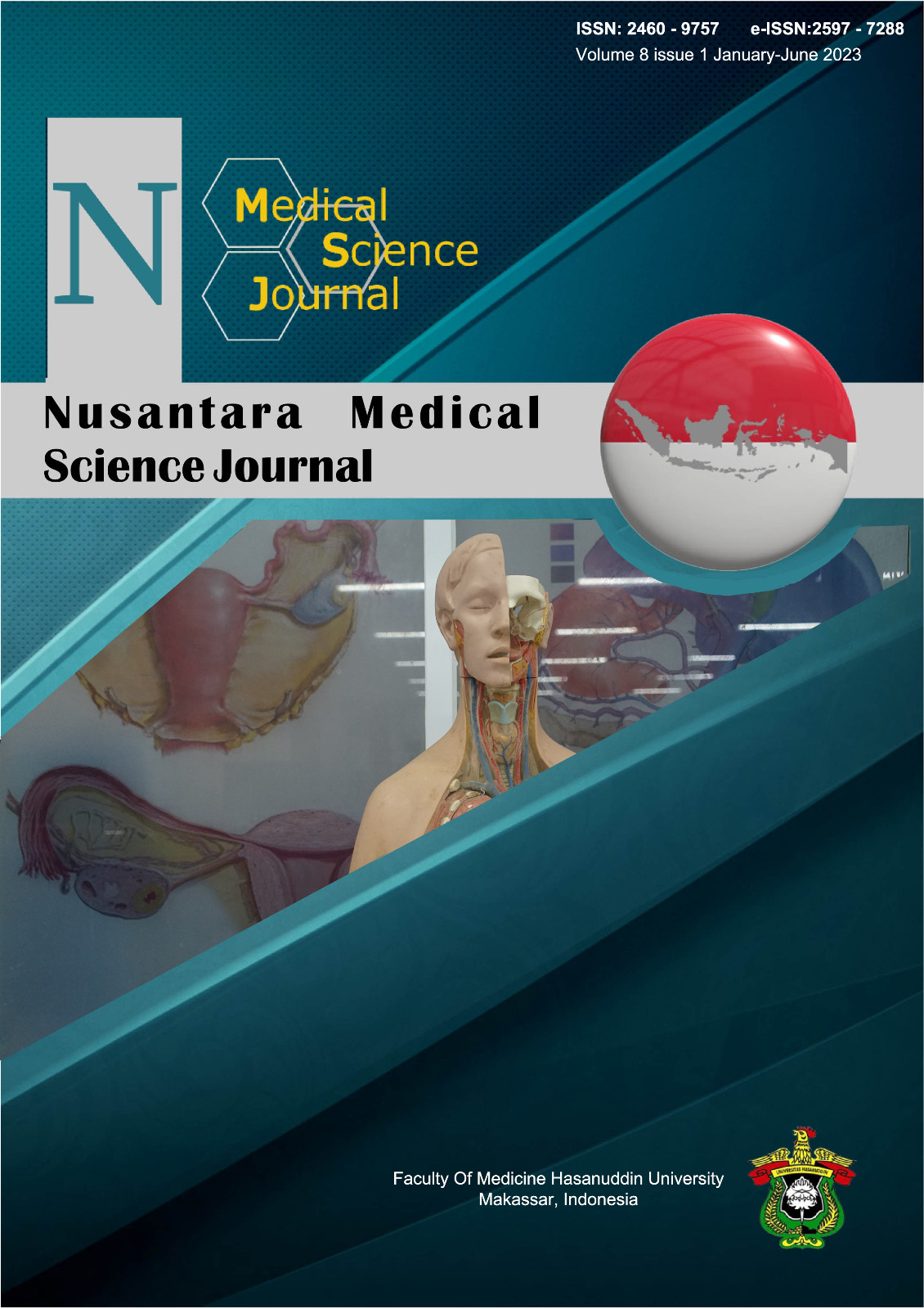Positive Fluid Balance as a Prognosis Predictor in Pediatric Sepsis Patients: A Retrospective Cohort Study
DOI:
https://doi.org/10.20956/nmsj.v8i1.23615Abstract
Introduction: Sepsis is one of the leading causes of infant and child morbidity and mortality worldwide. Fluid administration is an important way to reduce morbidity and mortality in septic patients with low blood flow and shock, since sepsis is often linked to low blood volume. The purpose of this study was to investigate the relationship between positive fluid balance and the outcome of pediatric sepsis patients. Methods: A retrospective cohort analysis of 80 pediatric patients diagnosed with sepsis using the 2005 International Pediatric Sepsis Consensus Conference (IPSCC) criteria. The positive fluid balance value was obtained from medical records and was evaluated using the Receiver Operating Characteristic (ROC) curve method. Results: Positive fluid balance was found to have a significant link with the outcome of pediatric sepsis patients (p<0.05).The positive fluid balance value of ≥4.61% was associated with mortality in pediatric patients with sepsis, with a sensitivity value of 62.79%, specificity of 62.16%, negative predictive value of 58.95%, and positive predictive value of 65.85%. The value of fluid balance in the first 24 hours of Pediatric Incentive Care Unit (PICU) care was higher in septic pediatric patients who died compared to those who improved, but not significantly (p=0.37). The value of total fluid balance during PICU care was higher in septic pediatric patients who died compared to those who improved (p<001).
Conclusions: Positive fluid balance with a cut-off value of 4.61% can be used as a prognostic factor in pediatric patients with sepsis.
References
Alobaidi, R., Morgan, C., Basu, R.K., Stenson, E., Featherstone, R., Majumdar, S.R., et al. (2013). Association between fluid balance and outcomes in critically ill children. JAMA Pediatrics. DOI: 10.1001/jamapediatrics.2017.4540
Wang, P., Jiang, L., Zhu, B., Du, B., Li, W., et al. (2021). Association of fluid balance trajectories with clinical outcomes in patients with septic shock: a prospective multicenter cohort study. https://doi.org/10.1186/s40779-021-00328-1
Raul, C., Willmer, D. (2019). Fluid overload in children with severe sepsis and septic shock. Am J Pediatr, 5(4). DOI: 10.11648/j.ajp.20190504.33
Mullan, P.C., Pruitt, C.M., Levasseur, K.A., Macias, C.G., Paul, R., Depinet, H., et al. (2022). Intravenous fluid bolus rates associated with outcomes in pediatric sepsis: a multi-center analysis. Emerg Med. https://doi.org/10.2147/OAEM.S368442
Goldstein, B., Giroir, B., & Randolph, A. (2005). International pediatric sepsis consensus conference: Definitions for sepsis and organ dysfunction in pediatrics. Pediatric Critical Care Medicine, 6(1). https://doi.org/10.1097/01.PCC.0000149131.72248.E6
Centers for disease control and prevention. CDC growth charts. Available from URL: https://www.cdc.gov/growthcharts/cdc_charts.htm [accessed on Sept 20th, 2022]
Ikatan Dokter Anak Indonesia. Kurva Pertumbuhan WHO. Available from:https://www.idai.or.id/professional-resources/kurva-pertumbuhan /kurva-pertumbuhan-who [accessed on Sept 20th, 2022]
Leteurtre, S., Duhamel, A., Salleron, J., Grandbastien, B. (2013). PELOD-2: an update of the pediatric logistic organ dysfunction score. Crit Care Med;41:1761–1773.
Rhodes, A., Evans, L.E., Alhazzani, W., Levy, M.M., Antonelli,M., Ferrer, R., et al. (2017). Surviving sepsis campaign: international guidelines for management of sepsis and septic shock: 2016. Intensive Care Med, 43:304-377. DOI: 10.1007/s00134-017-4683-6
Bulatova, Y. Y., Maltabarova, N. A., Zhumabayev, M. B., Li, T. A., & Ivanova, M. P. (2020). Modern diagnostics of sepsis and septic shock in children. Open Access Macedonian Journal of Medical Sciences, 8(5), 218–225. https://doi.org/10.3889/oamjms.2020.4554
Kong, X., Zhu, Y., & Zhu, X. (2021). Association between early fluid overload and mortality in critically-ill mechanically ventilated children: a single- center retrospective cohort study. BMC Pediatrics, 21(1), 1-10. https://doi.org/10.1186/s12887-021-02949-w
Sutawan, I. B. R., Wati, D. K., & Suparyatha, I. B. G. (2016).Association of Fluid Overloadd with Mortality in Pediatric Intensive Care Unit. Critical Care and Shock. 19(1), 8-13
Wong, J. J., Ho, S. X., Lee, A. O. C., Sultana, R., Chong, S. L., Mok, Y. H., Chan, Y. H., & Lee, J. H. (2019). Positive Fluid Balance is Associated with Poor Clinical Outcomes in Paediatric Severe Sepsis and Septic Shock. Annals of the Academy of Medicine, Singapore,48(9). 290-297
]Chapalain X, Vermeersch V, Egreteau PY, Prat G, Alavi Z, Vicaut E, et al. Association between fluid overload and SOFA score kinetics in septic shock patients: a retrospective multicenter study. J Intensive Care. 2019;7(1):42. https://doi.org/10.1186/s40560-019-0394-0.
Ma, Q., Wang, Y., Sun B., Wang, H., Xu, X., Yin Y., et al. (2022). Effect of a positive cumulative fluid balanceon the prognosis of patients with sepsis in the xining area. https://doi.org/10.21203/rs.3.rs-1035959/v3
Goligorsky M S, Sun D. Glycocalyx in Endotoxemia and Sepsis [J]. The American journal of pathology, 2020, 190(4): 791–8.
Iba T, Levy J H. Derangement of the endothelial glycocalyx in sepsis [J]. Journal of thrombosis and haemostasis: JTH, 2019, 17(2): 283 – 94.
Zampieri, F.G., Mazza, B. (2017). Mechanical ventilation in sepsis: a reappraisal. SHOCK. DOI: 10.1097/SHK.0000000000000702
da Silva., P.S., Fonseca, M.C . (2020). High-dose vasopressor therapy for pediatric septic shock: when is too much?. J Pediatr Intensive Care. https://doi.org/ 10.1055/s-0040-1705181.
Suari, R., Latief, A., & Pudjiadi, A. H. (2021). Paediatrica Indonesiana. 61(1), 39-45. https://doi.org/10.14238/pi61.1.2021.39-45
Rusmawatiningtyas, D., Rahmawati, A., Makrufardi, F., Mardhiah, N., & Murni, I.K. (2021). Factor associated with mortality of pediatric sepsis patients at the pediatric intensive care unit in a low-resource setting. BMC Pediatrics, 1-10. https://doi.org/10
Downloads
Published
How to Cite
Issue
Section
License
Copyright (c) 2023 Nusantara Medical Science Journal

This work is licensed under a Creative Commons Attribution 4.0 International License.









